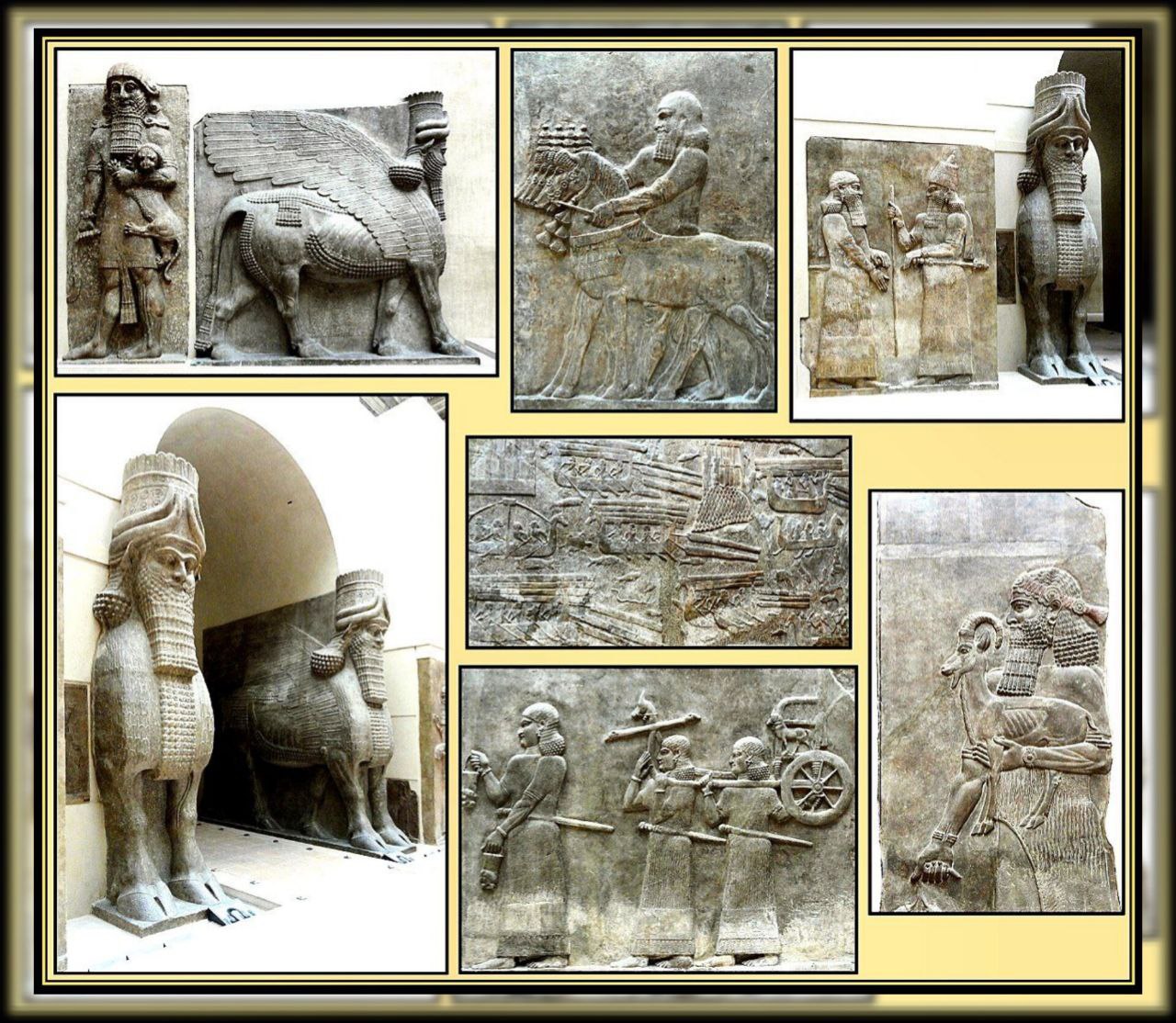Neo-Assyrian Period
The first obstacle which the Neo-Assyrian kings had to surmount was the resistance of Aramaean tribes which had settled in territory close to the heartlands of Assyria Itsel Gradually the Aramaeans were subjected and their kingdoms in North Mesopotamia and Syria were eventually annihilated, removing any possibility of counter-attack Assyrian Kings also subjugated Babylon and controlled the mountainous areas to north and the east. In order to keep a firm hold on the empire and to ensure the freedom of communications for their expanded trade, the Assyrian monarchs erected tresses or garrison buildings in many strategic positions. Their annals were recorded clay tablets or stone slabs, recounting in detail their military campaigns, hunting trins and other achievements,
The Neo-Assyrian period, which came to an end with the fall of Nineveh (612 B.Ccomprises the First and Second Empires and between them a period of decline.
First Neo-Assyrian Empire (912-745 B.C.)
Adad-nirari II (912-891 B.C.) The immediate task of this king was by internal reform to consolidate the military potential of Assyria. This enabled him to wage a successful series of campaigns in which he subdued several neighboring territories and entered into alliance with Babylon. From the time of Adad-nirari II the Assyrian recorded their annals year by year, using the limmu system of dating, by which they named after a different high official, usually beginning with the new king. We have continuous lists of these ‘eponyms’, which make possible a reliable dating of events in Assyrian history
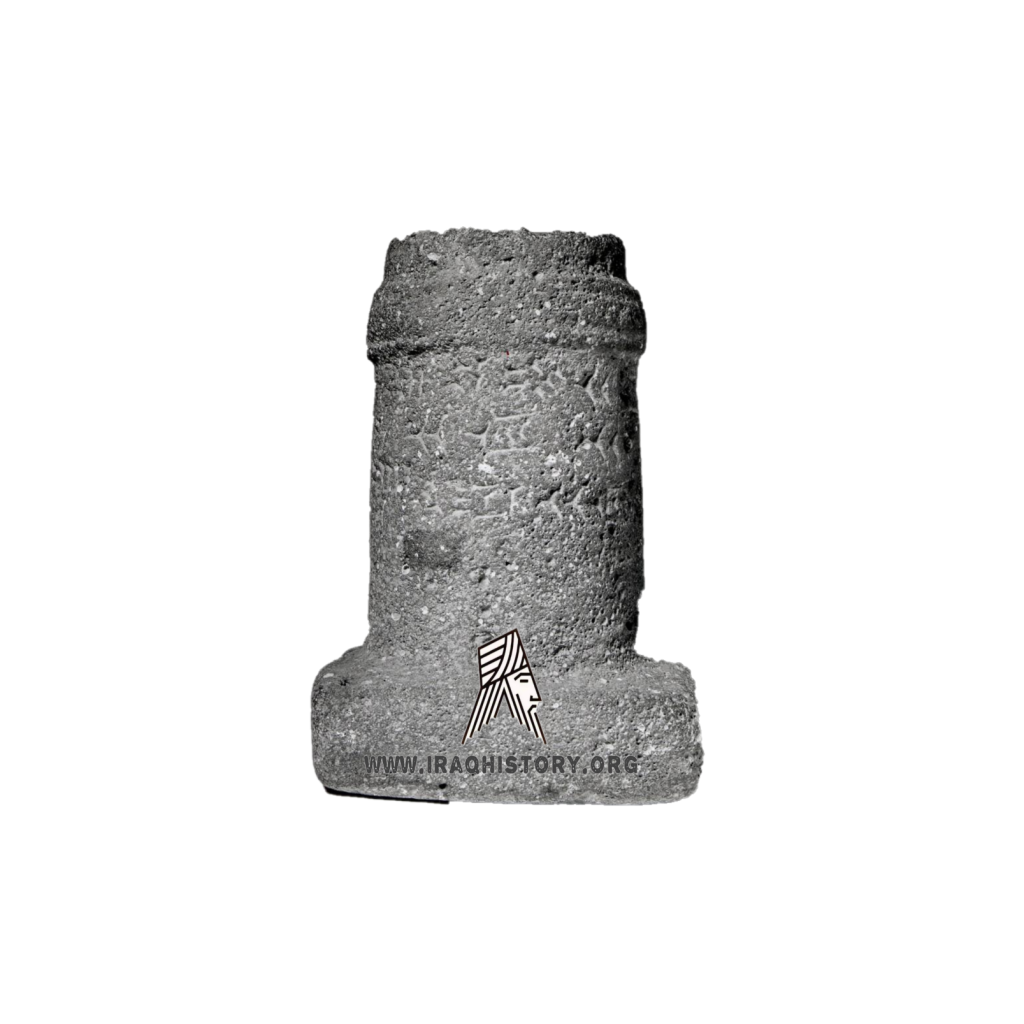
Basalt pedestal; inscribed with name and titles of Adad-nirari II; probably supported a sacred pole in front of one of the temple shrines
Adad-nirari’s successor on the throne was
Tukulti-Ninurta II (891-884 B.C.). who continued his predecessor’s policies, displaying Assyria’s military power, and securing overland trade and military routes by building new fortresses.
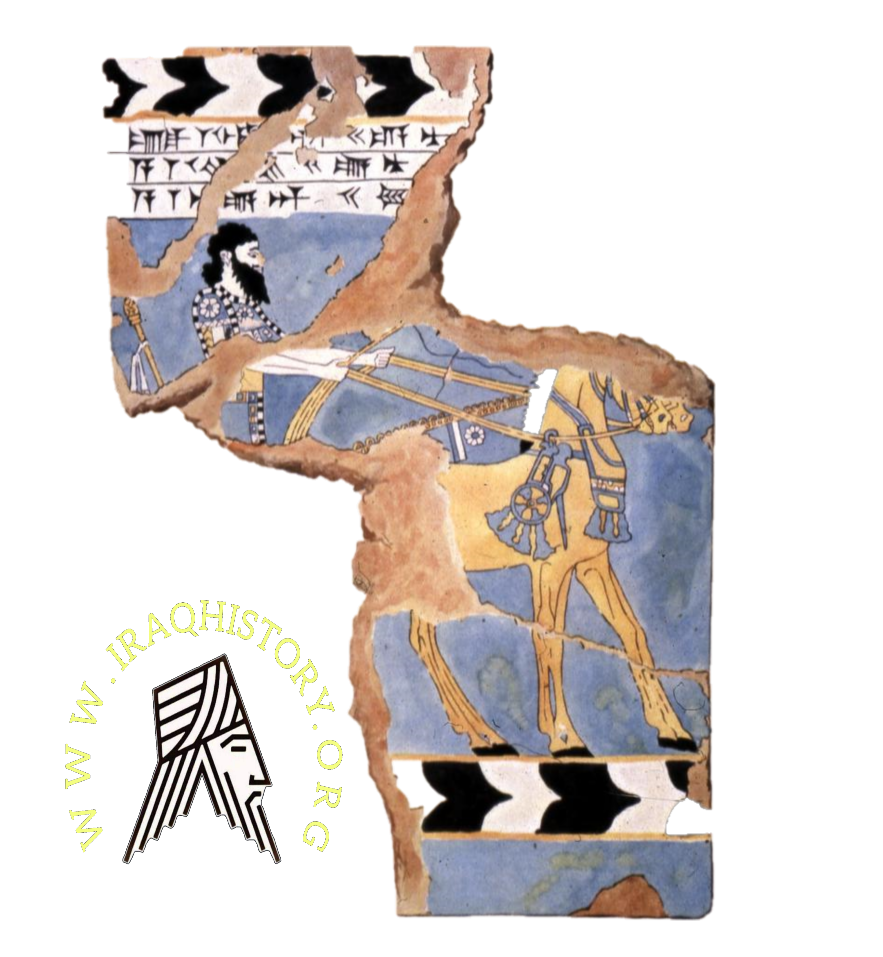
Glazed pottery brick from reign of Tukulti-Ninurta II;shows a charioteer border of painted chevrons top and bottom and painted inscription
He was succeeded on the throne by his son, the famous king:
Assur-nasir-pal II (885-858 B.C.) this illustrious ruler of Assyria carried his conquestsinto the northern and easternmountains, and tightened his grip onthevassal states of the empire. He fought the Aramaeans in the west, and brought all the land up to the Euphrates in Syria under his rule. His annals present him as a pitiless despot whose recorded atrocities make grim reading. He was however largely responsible for the army’s adoption of cavalry and instru-ments of siege warfare for the assault of fortified cities, and he reorganized the provincial system whereby each province was governed by an Assyrian official appointed by the king and responsible to him. Thus this fiercely destructive despot could also be creative, and among his accomplishments is the rebuilding of the city of Kalhu (biblical Calah, modern Nimrud). He constructed alongthe western side of the city a massive stone quay-wall on the Tigris, and for his own residence he built a magnificent palace, which is one of the most sumptuous monuments ever excavated in Iraq, with its frescoes and carved stone orthostats decorating the walls, depicting the achievements of the king in war or in the chase or the receipt of foreign tribute. A British expedition unearthed a large number of carved stone basreliefs more than a hundred years ago, and after World War II work was resumed bythe British School of Archaeology, yielding important results including the discovery of more stone bas-reliefs as well as was a remarkable sandstone monument, inscribed front and back with an account of the work undertaken by the king during the first five years of his reign, and describing the auspicious inauguration of the new palace of Assur-nasir-pal at Kalhu (Nimrud).

Ashurnasirpal II inscribed with 49 lines of engraved cuneiform text; lightly polished.
Records the king’s work on the temple of Ishtar Kidmuri, which is known to have existed at Nimrud Kalhu Mesopotamia Iraq before Ashurnasirpal (883BC-859BC) refunded the town as his capital city.
He erected a golden statue of the goddess in her shrine. The text ends with an invocation to some future restorer of the building. If he is respectful and simply adds his own name beside that of Ashurnasirpal, then the gods will give him success in war and general prosperity. If he erases Ashurnasipal’s name or mistreats the inscription in any other way, then there are curses he is to lose the throne and be captured by the enemy there is to be famine in the land and his name and posterity are to perish
.Shalmaneser III (858-824 B.C.) was the son and successor of Assur-nasir-pal II, and he added to the far-flung domain which he had inherited from his father by annexing more foreign territories, his conquests reaching up as far as the sources of the Tigris and Euphrates. Virtually all of his 35-year reign was spent on the battlefield, and one of his famous monuments, the ‘Black Obelisk’ (a monolith of black alabaster now in the British Museum) bears a long inscription recounting the king’s campaigns. (, is a big stone slab inscribed on both faces with the king’s annals and martial exploits.
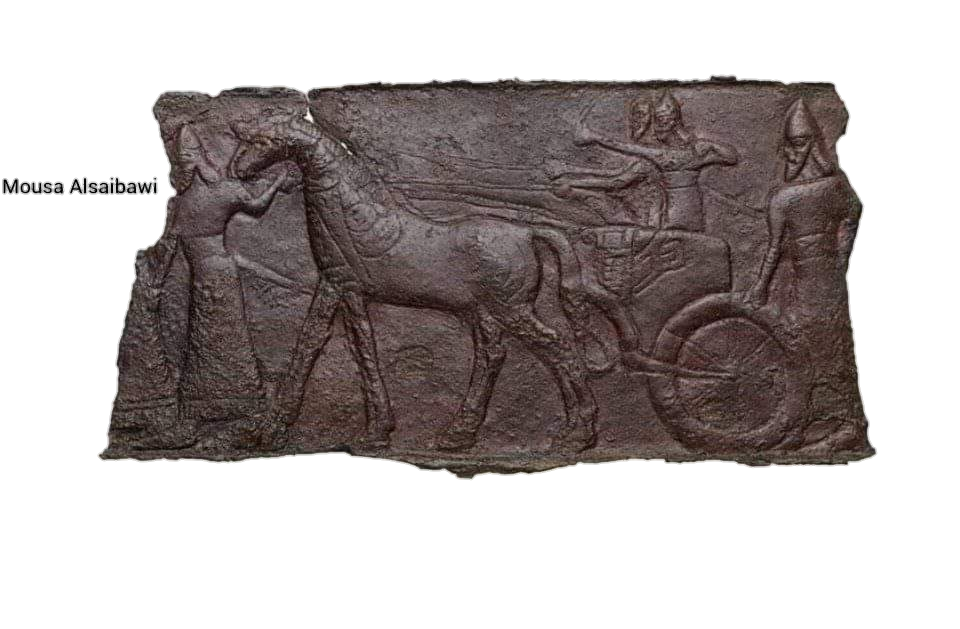
illustrating the military campaigns of the Assyrian king Shalmaneser III in Syria and Phenicia a chariot whose horses are driven by servants an archer in the chariot
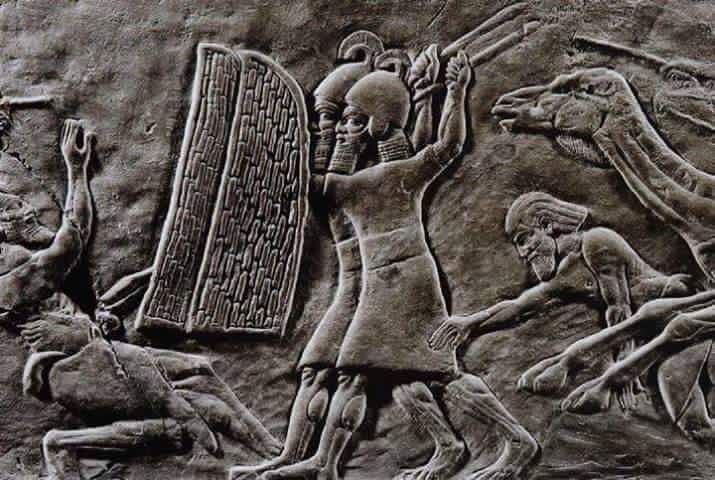
The Battle of Qarqar
was fought in 853 BC when the army of the Neo-Assyrian Empire led by Emperor Shalmaneser III encountered an allied army of eleven kings at Qarqar led by Hadadezer, called in Assyrian Adad-idir and possibly to be identified with King Benhadad II of Aram-Damascus; and Ahab, king of Israel. This battle, fought during the 854–846 BC Assyrian conquest of Aram, is notable for having a larger number of combatants than any previous battle, and for being the first instance in which some peoples enter recorded history, such as the Arabs. The battle is recorded on the Kurkh Monoliths. Using a different rescension of the Assyrian Eponym List would put the battle’s date at 854 BC
Twelve Kings
Twelve Kings is an Akkadian term meant to symbolize any kind of alliance. The most famous example is in the Kurkh Monoliths, where an alliance of 11 kings are listed as 12 in the Assyrian document as fighting against Assyrian King Shalmaneser III in the battle of Qarqar. Shalmaneser’s inscription describes the forces of his opponent Hadadezer in considerable detail as follows:[5]
King Hadadezer himself commanded 1,200 chariots, 1,200 horsemen and 20,000 soldiers;
King Irhuleni of Hamath commanded 700 chariots, 700 horsemen and 10,000 soldiers;
King Ahab of Israel sent 2,000 chariots and 10,000 soldiers (the number of Ahab’s forces is a subject of controversy among scholars);
The Kingdom of KUR Gu-a-a identified as Quwê-Cilicia sent 500 soldiers;
The land of KUR Mu-us-ra-[a] identified as Masura, which is the outlet of the Düden River, sent 1,000 soldiers;
The land of Irqanata (Tell Arqa) sent 10 chariots and 10,000 soldiers;
King Matinu Baal of Arwad sent 200 soldiers;
The land of Usannata[b] (in the Mount Lebanon region) sent 200 soldiers;
King Adunu Baal of Ušnatu (in the Syrian Coastal Mountain Range)[6] – figures lost;
King Gindibu of Arabia sent 1,000 camel cavalry;
King Ba’asa, son of Ruhubi, of the land of Ammon sent 100 soldiers.
The number of forces sent in by Ahab is a subject of controversy among scholars, since it seems unlikely that the Kingdom of Israel could possess an army superior to that of the Kingdom of Aram-Damascus. The number of chariots in Ahab’s forces was probably closer to a number in the hundreds (based upon archaeological excavations of the area and the foundations of stables that have been found).[7] Archaeologist Nadav Na’aman believes it to be a scribal error in regard to the size of Ahab’s army and suggested that he sent 200 instead of 2,000 chariots. Another possible explanation is that the forces attributed to Ahab include those belonging to his allies, such as the Kingdom of Judah, the Kingdom of Tyre and the Kingdom of Moab, although those kingdoms are not named in the monolith
Shalmaneser boasts that his troops inflicted 14,000 casualties upon the allied army, capturing countless chariots and horses, and describes the damage he inflicted on his opponents in savage detail. However, the royal inscriptions from this period are notoriously unreliable. They never directly acknowledge defeats and sometimes claim victories that were actually won by ancestors or predecessors. If Shalmaneser had won a clear victory at Qarqar, it did not immediately lead to further Assyrian conquests in Syria. Assyrian records make it clear that he campaigned in the region several more times in the following decade, engaging Hadadezer six times, who was supported by Irhuleni of Hama at least twice. Shalmaneser’s opponents held on to their thrones after this battle: though Ahab of Israel died shortly afterwards in an unrelated battle, Hadadezer was king of Damascus until at least 841 BC.
His armies foughtin Syria and Palestine, where they routed a coalition of the Jews and Aramaeans, penetrated into the uplands of Anatolia and northwestern Iran, and undertook punitive raids against the Arab tribes of the desert. With the conquests of Shalmaneser there spread the influence of Assyrian culture and religion, and in particular the worship of the paramount god of Assyria, Assur, who represented the state of Assyria itself. Towards the end of his reign, one of his sons revolted, causing serious internal dissension, and asresult Shalmaneser gradually lost control of most of the territories he had won. Therevolt was brought to an end by the triumph of Shamshi-Adad V over his Rebell the assistance of Hish brother, a victory which was achieved only with the king of Babylon Marduk-zakir-shumi. It may be from this time that the popular father’s of the Babylonian god Nabu in Assyria should be traced.
died, and his mother Sammuramat, the legendary Semiramis whose fame survives
Adad-nirari III (811-781 B.C.) was very young when his father Shamshi-Adaauthors, acted as regent for her son ube retold in various stories of the Greekhe reached maturity and was able to shoulder the burden of empire He displayed the qualities of a strong and enterprising king. At Tell Al-Rimah the British expedition king and an inscription recording the events of his reign (now in the Iraq Museum, Recently discovered a fine royal stele of Adad-nirarin III, bearing a relief portrait of the
X Item 22).succeeded by Assur-dan II, whose reign was marked by an epidemic of plague, and After him his son Shalmaneser IV. assumed power at Nimrud. and was in tinan eclipse of the sun that was later taken as a basis for computing the astronomical calendar, and which can be dated according to the estimates of astronomers to June 7of weakness was brought to a close by the accession of Tiglath-pileser III after a placebic. The position of Assyria was deteriorating, and the monarchy insecure. This period revolution at Nimrud, a vigorous sovereign who inaugurated the Second Neo-Assyrian Empire.
The Second Neo-Assyrian Empire (745-612 B.C.)
Tigiath-pileser (745-727 B.C.)
this king restored the fortunes of the Assyrian Empire and brought it to new heights of glory. An intelligent and understanding ruler, he made use of leniency and forbearance in his dealings with conquered lands Once his authority was established, he marched southwards, fighting the Aramaean and Chaldaean tribes and the Elamites, and relieved Babylon from their menace. In the north he then challenged the might of Sarduris of Urartu, who had profited from Assyrian weakness to extend his dominions, and succeeded in defeating him. The Aramaean states of Syria were next to receive his attentions and after receiving the submission of Aleppo and Damascus he proceeded onwards into Palestine and down the Mediterranean coast as far as the borders of Egypt. In a second campaign against Babylonia he penetrated deep into the south of the country, and took the opportunity to subdue the tribes of Bit-Yakin and the Arab chiefs of the desert. Like other Assyrian kingsTiglath-pileser adopted the policy of deportation, transferring masses of people from one conquered territory to another, and so creating from mixed communities the populations with common language and traditions. Large groups of the inhabitants Syria and Palestine were resettled in Babylonia and Assyria, and Babylonians transplanted northwards and southwards. After the death of Tiglath-pileser III his son Shalmaneser V, who held of King of Babylon and Assyria, had to deal with a revolt by the King of Israel, Hosea.
He besieged Samaria for three years, but died before completing his time stamping out rebellion and regaining territories held before, as he did in
Sargon II (722-705 B.C.) reigned for seventeen years. and had to spend as much making new conquests. His first undertaking was to continue with his predecessor’s

Gate of the Citadel of Assyrian king Sargon II Dur Sharrukin iraq Mesopotamia (photo taken during excavation in 40’s)
campaign against Samaria, which he captu red, bringing to an end the Kingdom ofal (721 B.C.). Then he took swift action to defeat a coalition of Syrian and Palestinianne and was able to win control over the rich maritime cities of Phoenicia. However the south of Iraq he was confronted by a revolt of the Chaldaean ruler Merodachan from the Bit-Yakin tribe near the Arab Gulf, who enlisted the support of the Flamites in his defiance of Assyrian authority and was able to take over Babylon ande of the southern cities. Sargon’s first punitive expedition despatched against theal was defeated, and Merodach-baladan held power in Babylonia for some ten years However. Sargon after this rebuff turned his attention to the north, where he strengakaned his hold, and routed a new coalition of Aramaean and Syrian states which was backed Hy the Egyptian pharaoh. He was then able to seek vengeance against Merodach-baladan.for his earlier defeat, and organized a successful campaign in which Babylon was captured, and Merodach-baladan who was deserted by his Elamite allies, was obliged to take refuge in the marshes in the south (709 B.C.). However, the Assyrians pursued him down into his kingdom of Bit-Yakin, which they overran; Sargon then forgave Merodachbaladan, and installed him as a vassal ruler of the south.
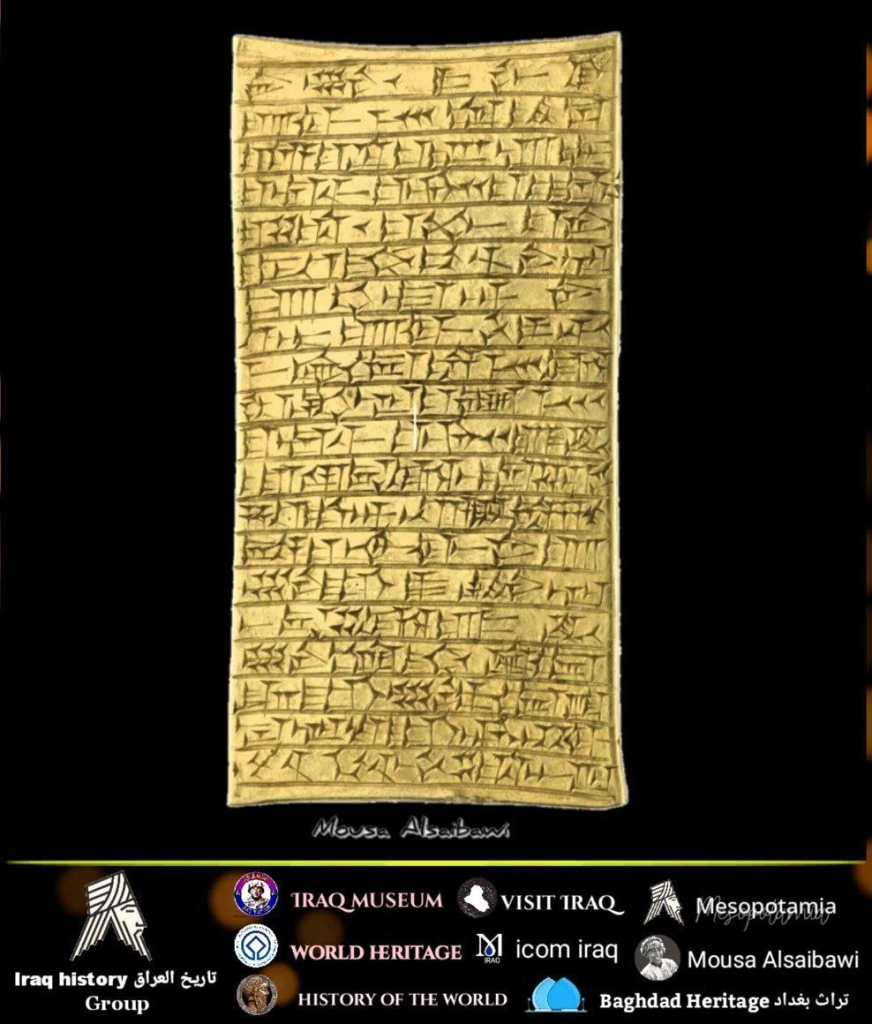
Foundation Tablet in Gold Provenience
From Dur-Sharrukin Assyrian city in mesopotamia Iraq
( 900-600 BC)
Found together with three other inscriptions on precious materials, including silver, the inscription commemorates Sargon II’s founding of the Neo-Assyrian capital at Dur-Sharrukin Typical of inscriptions found in the foundations of official buildings, this one includes information about the royal titulary of the king; his building activities in the city, including palaces and temples; and curse formulae against anyone who may destroy property of the king
Although Sargon, in the true tradition of Assyrian kings, maintained the supremacy of the god Assur and saw to the restoration of his temple, his most remarkable building achievement was the creation of a new capital for himself at Dur-Sharrukin, which is represented by the ruins of Khorsabad (probably for Chosroe Abad), a village some 18kms. northeast of Nineveh. The city gates and royal palace were adorned with frescoes and their walls lined with sculptured orthostats, while the traditional enormous stone figures with human heads and the bodies of bulls stood guard at the gates. Sadly, however. Sargon did not live to enjoy his new capital, since no more than a year after he had transferred to the completed city, he was slain in batle with the Cimmerian tribes which were sweeping across Anatolia from east to west.
Sennacherib (705-681 B.C.)
the son and successor of Sargon, did not choose to continue to reside in his father’s new capital and palace, but selected the ancient city of Nineveh as his capital, enlarged it, embellished its buildings, and provided artificial irrigation for its surrounding fields and gardens, to make it into a sort of paradise on earth. Sennacherib was a bold statesman and strong ruler, who is perhaps best remembered.
for his ruthless measures in dealing with his enemies. When Babylon revolted against him under Merodach-baladan, he sent a strong campaign into Babylonia which won a fierce battle and caused Merodach-baladan to flee, leaving the throne of Babylon vacant for nominee of Sennacherib who would be loyal to the Assyrian king. Sennacherib then led successful expeditions into Asia Minor and the plains of Cilicia, and descended on to the Phoenician seaboard, storming the allied cities of Sidon, Tyre, and Ashkelon, thus recapturing all the cities which had previously been subject to Assyrian sovereignty. His army besieged Jerusalem in the reign of king Hezekiah but was forced to withdrawn because of a sudden illness which affected the troops. Shortly after, Babylon once more revolted, probably as a result of the indignation of the priests and populace at Sennacherib’s treatment of the chief god of Babylon, Marduk, whom he had degraded, and ats conversion of Babylonia into a mere province of Assyria. Sennacherib there upon Kanised a massive punitive campaign against the insurgents, besieged and took Baby and installed on its throne one of his sons. Then, in order to settle the Babylonian Problem once and for all he determined to crush the states of the Sealand, which were
the source of all the anti-Assyrian intrigues. He therefore ordered his PhoeniGreek craftsmen to build a fleet of ships, and with these he sailed down the Eun through the wide areas of swamp, to the Gulf, where he was able to ravage the Sealana.In the Iraq Museum (Hall XII Item 10) there is a stone slab carved in relief wit scene from this campaign. However, in the meantime the Elamites, realizing that Senna-cherib was fully engaged in the south, seized the opportunity to invade central Meetamia, capturing Babylon and Sennacherib’s son. Initially, all Sennacherib could dhis prolonged campaigning in the south was to return to Nineveh and recuperate: his son he assembled a great army and marched on Babylon, defeating his opponents Then he exacted a terrible revenge on the city, burning it, and demolishing its temples houses, and fortifications, and leading the Euphrates over the city to complete the work of destruction, which was long remembered for its savagery.
Although Sennacherib was a ruthless enemy, we must not forget that he undertook much constructive work at home. Besides his extensive building activities, especially at Nineveh but in other cities too, he dug canals and initiated other hydraulic schemes Thus a great irrigation plan for the city of Nineveh involved the bringing of water from the River Gomel via the aqueduct of Jerwan, along canals whose banks might be re
in forced with masonry. Towards the end of his reign Sennacherib appointed his son Esarhaddon, whose mother was the Aramaean Naqiah, as crown prince, in defiance of the claims of his elder sons. As a result of this, one of his sons, with the assistance of a court faction, rosin revolt and murdered Sennacherib (681 B.C.).Esarhaddon (681-669 B.C.) when Sennacherib died Esarhaddon was in the north
campaigning in Armenia. From there he hastened towards Nineveh, quelled the rebellion mountains of Armenia. From there he hastened towards Nineveh, quelled the rebellion, and entered the city in triumph. His policy towards Babylon was one of conciliation: he restored the city and its temples, and place’s his elder son Shamash-shum-ukin on the throne of Babylon. After putting down yet another revolt in southern Babylonia by there irrepressible SeaLand Dynasty, he was able then to turn his attention elsewhere. In 676B.C. he marched to the Syrian and Phoenician coast, receiving the submission of all the cities both inland and on the sea. Gifts and tribute were brought to the Assyrian king from all these local rulers, and from further afield such as Cyprus and Cilicia. However the name of Esarhaddon is particularly associated with his daring invasion of Egypt. It seemed necessary to intimidate the Egyptian Pharaoh Taharqa, whose armies had oftenserved as the backbone of resistance to Assyrian progress in Syria and Palestine.Marching southwards therefore, the Assyrian army attacked the Egyptian borders, defeating Tahraqa and his army (673 B.C.). Two years later, after their return to Nineveh,a second offensive was planned, and after routing the Egyptian resistance from the Deltaregion, Memphis, the royal residence of Taharqa, was besieged and captured, and the Pharaoh fled to Upper Egypt, leaving the Assyrian armies to carry away countless spcilfrom Memphis, and an Assyrian garrison installed in the city. No doubt from this campaign come some Egyptian relics discovered by the Directorate-General of Antiquities during its excavations at Tell Nebi Yunus. On his triumphal march homeward Esarhaddon had his image carved on the rocks of the Dog River (Nahr-el-kelb) near Beirut, to commemorate his victories. During the reign of Esarhaddon we first hear of unrest in the northeast, which foreshadows a much greater and finally fatal threat to Assyria in later years: we hear of waves of nomadic tribes moving across Asia Minor, and in the east,of the Medes, who were establishing themselves as a power in the great Iranian plateau.
de the end of his reign Esarhaddon proclaimed his son Assur-bani-pal the legate heir to the throne and established another of his sons. Shamash-shum-ukin.the king in Babylon but with allegiance to his brother the Assyrian king. It was ins R.C.. when he was leading once again a campaign against Egypt, that Esarhaddon fell sick and died en route.
Assur-bani-pal (669-629 B.C.).
who succeeded his father, is perhaps justly most famed or his interest in literature and the fine arts. He created a great library at Nineveh, for which he collected, and had translated, all the Sumerian or Akkadian literary texts on which he could lay his hands. This is the library which was discovered at Nineveh. Immediately after his accession, of course, Assur-bani-pal inherited the task of
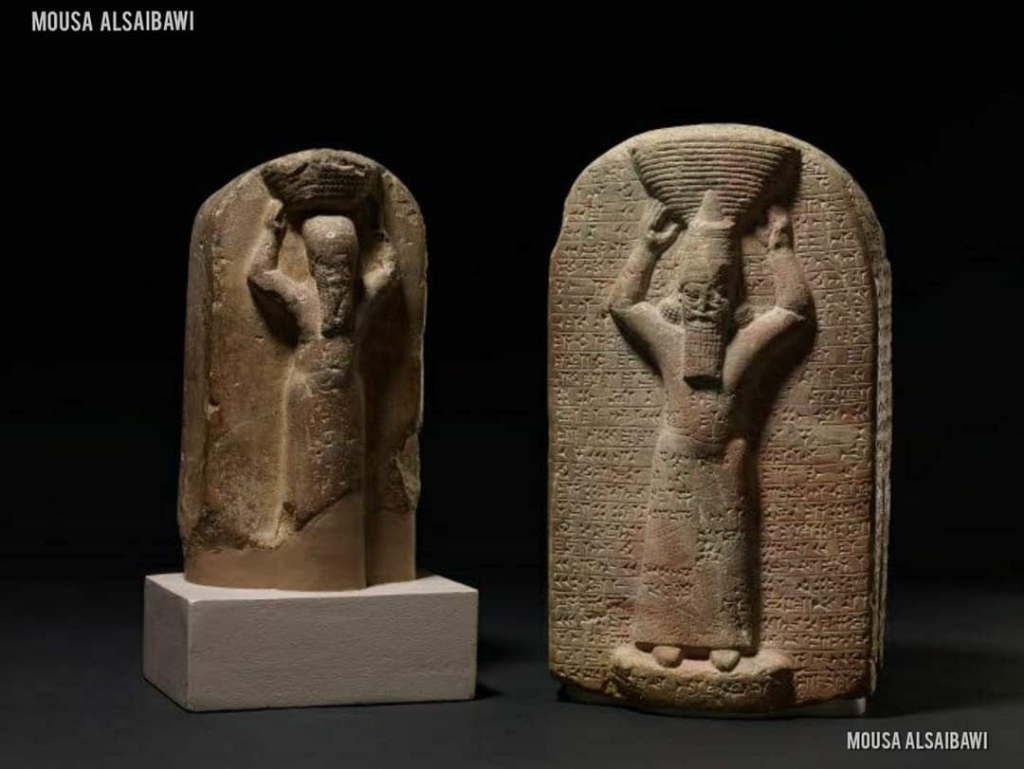
Stone stela of Shamash-shum-ukin carved with cuneiform inscription the front of the stela was defaced but the hidden inscription on the back remained safe represents the king as a standing figure with a basket on his head to indicate his symbolic role as a builder Stone stela of Ashurbanipal the king is shown with a ritual basket of earth on his head as royal builder for the accession of Shamash-shum-ukin and the restoration of Esagila in Babylon Cuneiform inscription on the front and backdate
Mesopotamia iraq
668BC-655 BCE
suppressing the Egyptian revolt, and he ordered the Commander-in-Chief, Sha-Nabu-shu,to resume his father’s campaign. The Assyrian army therefore took the road to Egypt, occupied the Delta, and routed the troops of Taharqa and other Egyptian princes. The then took Memphis, and pursued Taharga to his capital in Upper Egypt, which the captured. Thus the whole country fell under Assyrian control, and Assur-bani-pal installed local rulers such as Psammetichus, concluding with them treaties which bound them to send tribute and observe their loyalty to Assyria. After the Assyrian withdrawal from Egypt all provinces came under the control of Psammetichus, who founded the 26thDynasty, which was loyal to the Assyrians.
As for Babylon, at the time of Assur-bani-pal’s accession, his brother took the throne of Babylon as their father had arranged, and for some 20 years they behaved as faithful brothers. However, in the end Shamash-shum-ukin was infected by the spirit of revolt in Babylonia, and in alliance with Elam declared war on his brother and overlord, the King of Assyria. Assur-bani-pal led a punitive campaign against his brother, laid siege to Babylon, and ravaged it by fire, Shamash-shum-ukin dying in the flames of his own palace. At the same time, Assur-bani-pal proceeded southwards to punish the Aramaean and Arab tribes which had lent their support to the rebel, and subdued them after prolonged fighting He then sent his troops against Elam, sacked the capital, Susa, plundered it, and even violated the graves of its kings. This left him undisputed ruler of the whole of the Near East.
campaign against Samaria, which he captu red, bringing to an end the Kingdom ofal (721 B.C.). Then he took swift action to defeat a coalition of Syrian and Palestinianne and was able to win control over the rich maritime cities of Phoenicia. However the south of Iraq he was confronted by a revolt of the Chaldean ruler Merodachan from the Bit-Yakin tribe near the Arab Gulf, who enlisted the support of the Flemates in his defiance of Assyrian authority and was able to take over Babylon Ande of the southern cities. Sargon’s first punitive expedition dispatched against Theal was defeated, and Merodach-baladan held power in Babylonia for some ten years However. Sargon after this rebuff turned his attention to the north, where he strengakaned his hold, and routed a new coalition of Aramaean and Syrian states which was backed Hy the Egyptian pharaoh. He was then able to seek vengeance against Merodach-baladan.for his earlier defeat, and organized a successful campaign in which Babylon was captured, and Merodach-baladan who was deserted by his Elamite allies, was obliged to take refuge in the marshes in the south (709 B.C.). However, the Assyrians pursued him down into his kingdom of Bit-Yakin, which they overran; Sargon then forgave Merodachbaladan, and installed him as a vassal ruler of the south.
Although Sargon, in the true tradition of Assyrian kings, maintained the supremacy of the god Assur and saw to the restoration of his temple, his most remarkable building achievement was the creation of a new capital for himself at Dur-Sharrukin, which is represented by the ruins of Khorsabad (probably for Chosroe Abad), a village some 18kms. north east of Nineveh. The city gates and royal palace were adorned with frescoes and their walls lined with sculptured orthostats, while the traditional enormous stone figures with human heads and the bodies of bulls stood guard at the gates. Sadly, however. Sargon did not live to enjoy his new capital, since no more than a year after he had transferred to the completed city, he was slain in battle with the Cimmerian tribes which were sweeping across Anatolia from east to west.
Sennacherib (705-681 B.C.), the son and successor of Sargon, did not choose to continue to reside in his father’s new capital and palace, but selected the ancient city of Nineveh as his capital, enlarged it, embellished its buildings, and provided artificial irrigation for its surrounding fields and gardens, to make it into a sort of paradise on earth. Sennacherib was a bold statesman and strong ruler, who is perhaps best remembered
for his ruthless measures in dealing with his enemies. When Babylon revolted against him under Merodach-baladan, he sent a strong campaign into Babylonia which won a fierce battle and caused Merodach-baladan to flee, leaving the throne of Babylon vacant for nominee of Sennacherib who would be loyal to the Assyrian king. Sennacherib then led successful expeditions into Asia Minor and the plains of Cilicia, and descended on to the Phoenician seaboard, storming the allied cities of Sidon, Tyre, and Ashkelon, thus recapturing all the cities which had previously been subject to Assyrian sovereignty. His army besieged Jerusalem in the reign of king Hezekiah, but was forced to withdrawn because of a sudden illness which affected the troops. Shortly after, Babylon once more revolted, probably as a result of the indignation of the priests and populace at Sennacherib’s treatment of the chief god of Babylon, Marduk, whom he had degraded, and ats conversion of Babylonia into a mere province of Assyria. Sennacherib there upon Kanised a massive punitive campaign against the insurgents, besieged and took Baby and installed on its throne one of his sons. Then, in order to settle the Babylonian Problem once and for all he determined to crush the states of the SeaLand, which were
FALL OF NINEVEH AND THE END OF ASSYRIA
Assur-etelli-ilani (629-627 B.C.)
After the death of Assur-bani-pal the succession wash disputed, but after various intrigues his son Assur-etelli-ilani occupied the throne. He was probably young at the time of his accession, and was dependent on the help of the Commander-in-Chief, Sin-shum-lishir, in his efforts to suppress revolts both in the provincesand in Assyria itself. Many of the outlying provinces managed to cast off the Assyrian yoke entirely, Egypt, for example, becoming independent although it remained loyal toAssyria. The cities of the Mediterranean Coast and Syria severed their ties with Assyriaalso, and in Babylonia a Chaldaean prince called Nabopolossar founded an independent dynasty, uniting Babylonia under him and extending his authority over cities and districts which had been subject to Assyria. At Nineveh, the domestic scene was not peaceful either. Sin-shum-lishir revolted.
against his master and attempted to rule Assyria himself, but he in his turn was ousted by Sin-shar-ishkun, who managed to keep his seat on the throne for some years, and income measure restore Assyria’s waning fortunes. However, the internal dissension only served to accelerate the break-up of the Assyrian empire, and many of its territories fell away. In the north, it is true, the Anatolian kingdoms and the distant Lydians kept up their allegiance to Assyria, but this was only as a counter-measure to the growing might of the Medes, who under their new king Cyaxares had become masters of northern Iran and engaged in conflict with the Assyrian state itself. In the end Assyria met its final blow from the alliance of Cyaxares the Mede and the Babylonian ruler Nabopolassar, who marched with their combined forces against Nineveh, besieged, and captured it after fierce fighting (612 B.C.).
After the fall of Nineveh, Cyaxares took the north-eastern part of the realm of Assyria, while Nabopolassar was assigned the south. Meanwhile his son, Nebuchadnezzar.was sent to pursue the remnants of the Assyrian armies, which had fled under the kingAssur-uballit II to the western Assyrian capital of Harran. Nebuchadnezzar in fact encountered little resistance from Assur-uballit, and in 609 B.C. Harran itself fell to him,and so marked the final downfall of the Assyrian Empire which had held sway bysheer force and terror over the whole of the Near East. After this Nebuchadnezzar advanced westwards to the upper Euphrates, occupying Assyria’s one time possessions, andin 605 B.C. he met the Egyptian army under its Pharaoh Necho (son of Psammetichus)who had been allied with Assyria. The Egyptians had marched up through Palestine and Syria, fighting as they went, and the Pharaoh stopped at the Dog River by Beirut to carve his figure commemoration of his victories. Possibly as a result of this earlier fighting however, the Egyptian army was no match for the Babylonians, and they suffered agave defeat at Carchemish on the Euphrates, after which Necho was forced to retire to within his own borders.
Faraj Basmachi + Harvard University + British Museum + Iraq Museum + Louvre Museum + University of Chicago


